Features

Adaptive cruise assist
The adaptive cruise assist (ACA) assists the driver with longitudinal and lateral control over the entire speed range – substantially enhancing comfort on long journeys, in particular. It incorporates the functions of adaptive cruise control, traffic jam assist and active lane assist. Depending on the model, the ACA uses the radar sensor in the nose of the vehicle, the laser scanner, the front camera and the ultrasonic sensors to permanently monitor the vehicle’s surroundings.
Depending on the sensor set, the system detects lane markings, roadside structures, vehicles in adjacent lanes and vehicles driving ahead. The ACA uses this information to derive a virtual vehicle path and “guides” the vehicle within it. The system also includes helpful steering intervention so that the vehicle remains in the center of the lane. In some models based on the modular longitudinal platform, the system uses also the laser scanner: The ACA detects if the lane is too narrow to allow side-by-side driving and enables offset driving through narrow stretches.
The adaptive cruise assist maintains proper speed and following distance via targeted acceleration and braking. The car automatically adapts its speed to the traffic situation and the route, for example at curves and cross-ways. In stop-and-go traffic as well as traffic jam situations, the ACA can bring the car to a complete stop. Depending on the duration of the stop, the car can start automatically again.
Adaptive cruise assist
The adaptive cruise assist (ACA) assists the driver with longitudinal and lateral control over the entire speed range – substantially enhancing comfort on long journeys, in particular. It incorporates the functions of adaptive cruise control, traffic jam assist and active lane assist. Depending on the model, the ACA uses the radar sensor in the nose of the vehicle, the laser scanner, the front camera and the ultrasonic sensors to permanently monitor the vehicle’s surroundings.
Depending on the sensor set, the system detects lane markings, roadside structures, vehicles in adjacent lanes and vehicles driving ahead. The ACA uses this information to derive a virtual vehicle path and “guides” the vehicle within it. The system also includes helpful steering intervention so that the vehicle remains in the center of the lane. In some models based on the modular longitudinal platform, the system uses also the laser scanner: The ACA detects if the lane is too narrow to allow side-by-side driving and enables offset driving through narrow stretches.
The adaptive cruise assist maintains proper speed and following distance via targeted acceleration and braking. The car automatically adapts its speed to the traffic situation and the route, for example at curves and cross-ways. In stop-and-go traffic as well as traffic jam situations, the ACA can bring the car to a complete stop. Depending on the duration of the stop, the car can start automatically again.

Hold assist
Hold assist enables convenient drive-offs when the car is on the usual inclines and descents of street traffic, and it prevents the vehicle from rolling. The system automatically switches over to the electromechanical parking brake when the car is stopped for a longer period of time while hold assist is activated. This ensures that the car will remain stationary even without activation of the parking brake. In conjunction with S tronic, after a stop at a traffic light, for instance, the car drives off as soon as the driver presses the accelerator pedal. The system is activated by pushing a button.
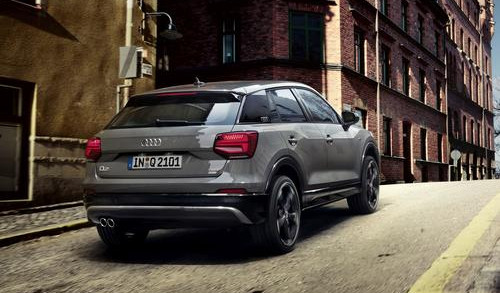
Audi pre sense basic
Audi pre sense basic initiates preventive safety measures for occupants as soon as it recognizes a critical driving state. It utilizes information from various vehicle systems to determine this. For instance, it intervenes if the Electronic Stabilization Control (ESC) sensors detect skidding or hard braking. Then the system pretensions the seat belts of the driver and front passenger electrically to reduce their forward or lateral movements. The side windows and sliding sunroof are automatically closed. In addition, the hazard warning lights are activated to alert following traffic.

High-beam assist
High-beam assist utilizes a camera mounted on the interior mirror. It detects light sources – the headlights of oncoming vehicles, tail lights of other road users and the reflections of municipality limit signs, for instance – and automatically switches between high beam and low beam lighting. This provides for better visibility and a more relaxed driving experience. Drivers of oncoming vehicles are not blinded by glare.
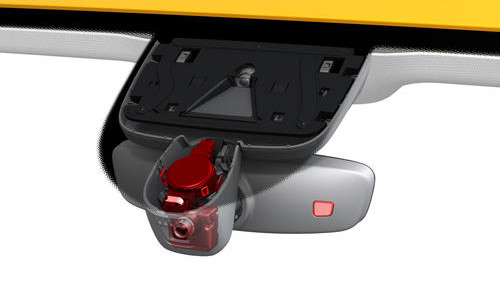
Cruise control
Cruise control maintains a desired driving speed constantly starting at around 30 km/h (18.6 mph) (model dependent), provided that it can be maintained by engine power and engine braking effects. The system offers relief to drivers in this way – especially on long trips. At the same time, the constant speed mode of driving contributes towards lower fuel consumption and lower CO2 emissions. The system is operated via a separate steering column stalk, and the preset driving speed is shown in the instrument cluster. The system is deactivated when the driver brakes.
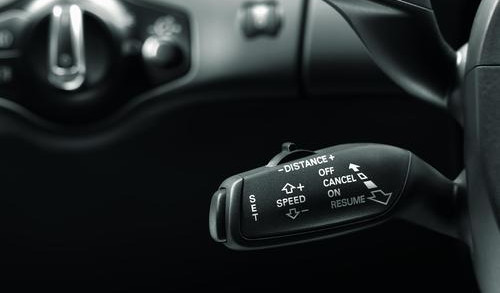
(Predictive) efficiency assist
Efficiency assist helps the driver to drive preemptively and save fuel. The system works closely together with adaptive cruise control (ACC) or adaptive cruise assist (ACA). It accesses predictive route data from navigation and Car-to-X information. In order to detect traffic signs and other vehicles, the efficiency assist uses the front camera as well as data from the front and rear-facing radar sensors.
The driver is shown corresponding information in the instrument cluster or in the Audi virtual cockpit and the head-up display as soon as it would be sensible to take the foot off the right-hand pedal. Symbols for speed limits, bends, roundabouts, towns, or downhill slopes that indicate to the driver to slow down are displayed on the basis of the route data and recognition of traffic signs. Depending on the model the gas pedal also pulses against the sole of the driver’s foot – a clear indication to take their foot off the gas.
If the cruise assist is switched on or the ACC is activated, efficiency assist regulates actively. It decelerates and accelerates predictively and adapts the speed to the course of the road and the traffic situation, also taking vehicles driving in front into account. If the driver so wishes, the system controls the freewheeling and coasting operation of the engine in cooperation with other control units. The predictive system always maintains a driving style that reflects the driving program selected – from efficient to sporty – and uses scope for recuperation in the Audi e-tron.
The driver can override the system at any time by accelerating and braking. In addition, drivers can individually activate, deactivate and configure many of their detailed functions in the MMI. Depending on the model, the control, for example, can be adapted to the course of the road in three stages: slow, medium or fast.
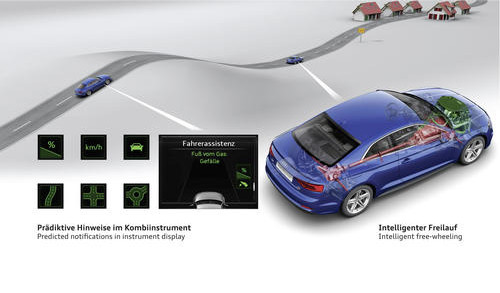
(Remote) parking pilot and remote garage pilot
The (remote) parking pilot and the remote garage pilot make parking extremely easy and convenient. Both systems enable the car to roll automatically into parallel or perpendicular parking sports or into a garage. They control the steering, the gas, the brakes and the automatic transmission. The driver either sits in the car (parking pilot) or monitors the maneuver from outside via smartphone (remote parking pilot and remote garage pilot).
He or she activates the respective systems using the parking button on the MMI display. If the vehicle is moving at a moderate speed the ultrasonic sensors measure the parking spaces along the road. The garage pilot also uses the laser scanner. A message appears on the MMI display when the system finds a suitable spot. The driver can now stop, select smartphone control in the MMI, get out and start the parking maneuver from his or her phone. This is done by pressing the Audi AI button in the myAudi app and holding it during the entire parking procedure. The driver sees a live image from the 360 degree cameras on the smartphone display. The maximum distance from the car is six meters (19.7 ft). The car pulls into the parking space at a speed of up to 6 km/h (3.7 mph), maneuvering multiple times if necessary. The car can only pull forward into a garage. Once the vehicle reaches its final position, the tiptronic is set to P and both the engine and the ignition are turned off. When it's time to leave again, the driver can start the car using the smartphone and have it pull out of the parking spot or the garage.
The driver can also start the parking pilot while still sitting behind the wheel by pushing the AI button on the center tunnel console. This button must also be pressed throughout the entire parking procedure.
The (remote) parking pilot and the remote garage pilot function intelligently and conveniently. For instance, the sedan can also pull into a garage if it needs to drive in an arc to do so. Inside the garage, the car can pull very close to walls and obstructions such as bikes – or it will simply not enter the garage if there is not enough space. Its innovative laser scanner is particularly helpful here.
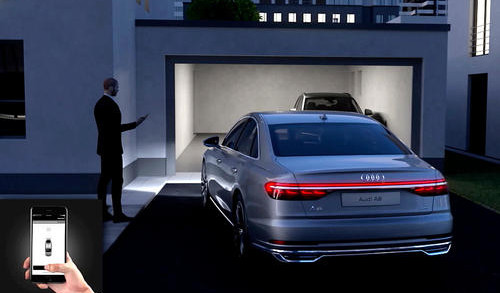
Reversing camera
The reversing camera simplifies maneuvering by showing the zone behind the vehicle on the MMI display. It shows the calculated driving track based on the steering angle as well as auxiliary lines and guide lines. For parallel parking, the latter lines precisely direct steering into the parking space in conjunction with steering reversal points. The blue pictured surface in the camera image indicates where the vehicle will be positioned after the parking procedure. The reversing camera is inconspicuously integrated into the handle trim strip of the luggage compartment lid. It is activated as soon as the driver engages reverse gear or pushes the respective button.
